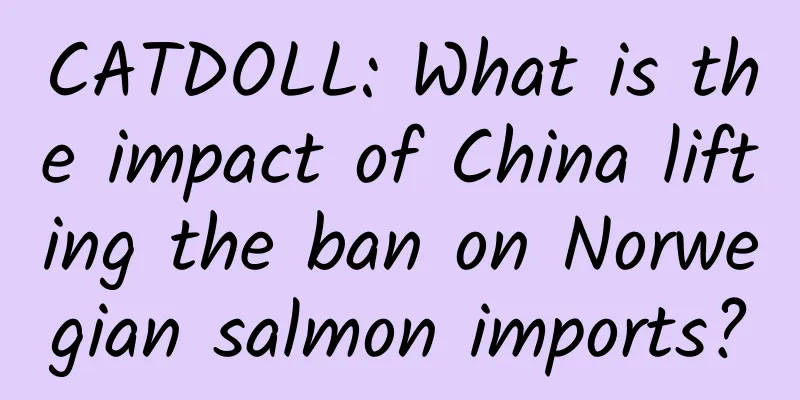CATDOLL : CATDOLL: What is the impact of China lifting the ban on Norwegian salmon imports?

1. What are the impacts of China lifting the ban on Norwegian salmon imports?On the morning of July 6, Biting Siming, head of the Norwegian Seafood Foreign Trade Council's office in China, told the media that China had lifted some of its import bans on Norwegian salmon starting from July 3. Affected by this, the amount of Norwegian salmon imported by China is expected to increase significantly from the second half of this year. China has repeatedly banned the import of some Norwegian salmon due to virus threats. In September 2014, the Norwegian Food Safety Authority announced that China plans to ban the import of whole Norwegian salmon until importers can prove that the imported salmon are free of the infectious salmon anemia virus and other variants of the virus. The ban was not implemented. However, in March 2015, the Chinese government officially ordered that imports of 100 tons of tartar from Sor-Trondelag and Nordland counties in Norway be stopped from March 23. ) and Troms counties. The remaining counties can still export salmon to China, but they must provide proof that the salmon are free of pancreatic disease (PD) and infectious salmon anemia (ISA). According to Bismin, the three counties that received the ban account for 40% of Norway's salmon production. After the ban was issued, China's salmon import figures changed. According to customs data, in 2015, China imported 14,902 tons of fresh salmon from the Faroe Islands, a Danish autonomous region, ranking first, and only 3,537 tons from Norway, ranking sixth. In 2014, China's imports of fresh salmon from Norway accounted for 32.14% of the total, ranking first. Source: Sina News 2. What are the main production areas of salmon on the market? How safe are they?The main producing areas of commercial salmon are the Faroe Islands, Norway, Chile, the United Kingdom (mainly Scotland), Australia and Canada. According to Chinese customs data, in 2015, China imported 14,902 tons of fresh salmon from the Faroe Islands, ranking first, and only imported 3,537 tons from Norway (only counting customs channels), ranking sixth. The countries ranked second to fifth were Chile, the United Kingdom (mainly Scotland), Australia and Canada. The safety performance of imported salmon needs to be improved: In 2014, China banned the import of Norwegian salmon because "infectious salmon anemia (ISA) virus and other variants were detected in Norwegian exported salmon"; in June 2020, the new coronavirus was detected on the cutting board used to cut imported salmon at Beijing Xinfadi Market; in mid-June 2020, foreign media exposed the "farming sins" of Norwegian salmon, with crowded and dirty farming conditions and many sick fish covered with ulcers. Additional information: Salmon farming sins According to an investigative report by the Franco-German Public Television (ARTE) on the 14th, in order to find out why the number of farmed salmon deaths worldwide reached 50 million in 2018, the station's reporters conducted a field investigation in Norway, the hometown of salmon. The reporter sneaked into the farm and saw a large number of fish crowded in dirty seawater filled with their excrement. Many sick salmon were covered with ulcers as big as palms, and some had become S-shaped deformed fish. In addition, high-density breeding has also caused fish lice to become rampant. In addition to the poor breeding conditions, farmed salmon also threaten the survival of wild salmon. Skara, a researcher at the Norwegian Institute of Marine Research, said that there are currently about 530,000 wild salmon in Norway, and 400 million farmed salmon. Every year, about 183,000 farmed salmon escape from farms and enter the ocean. Not only do they compete with the latter for food, but they also infect the latter with fish lice. The offspring of the two have poor adaptability and low reproductive capacity, which directly "pollutes" the genes of wild salmon. Wild salmon eat shrimp and crabs in the ocean, which makes them rich in Omega-3 fatty acids, and astaxanthin gives salmon meat a bright color. However, in order to make farmed salmon grow quickly, people feed them a mixture of soy plant protein and chemically synthesized astaxanthin, so the quality of farmed salmon is far inferior to that of wild salmon. Reference source: China.com - Foreign media exposes the "evil of salmon farming" in Norway. The horrific scene makes people feel sick! Reference source: Jiangsu Metropolis Network - Foreign media exposed the "evil" of Norwegian salmon farming: the farming conditions are crowded and dirty 3. These salmon contain antibiotics and parasites, so don’t buy them for your babyFollowing the cod chapter, the salmon chapter is also out. Salmon also has real and fake salmon. Although it is not as complicated as cod, the origin (Norway or Denmark or Chile or Australia) and transportation method (fresh or frozen) are still quite a headache. In order to enrich the baby's dining table, Xixi has completed the salmon chapter of the handbag for everyone to enjoy. Instructions for use: The "Hand-in Package" includes a "too long picture" and a detailed guide article. One picture can solve a thousand worries, one article can answer a thousand questions, you can choose We have previously explained in "Real cod is good for the brain, fake cod and nuclear wastewater cod are harmful to the body, one picture to help you choose baby cod!" that the criteria for choosing seafood are high DHA, low EPA, low mercury and low sodium, so we will not repeat them here. Compared to cod, salmon has lower mercury content and is one of the top seafood choices by the FDA. Salmon is not subject to the total gram limit of seafood intake per week, which saves parents from the pain of calculation. In addition, the protein, fat and B vitamins in salmon are comparable to lean meats such as chicken and beef, and its nutritional value cannot be underestimated. Does this mean salmon can be eaten as much as you want? Not necessarily. There are four basic principles for choosing salmon for your baby: marine fish is better than freshwater fish, farmed fish is better than wild fish, small fish is better than big fish, and frozen fish is better than chilled fish. First of all, the risk of parasites in marine fish is lower than that in freshwater fish, and in farmed fish is lower than that in wild fish. Secondly, because mercury accumulates in fish, that is, "big fish eat small fish, small fish eat shrimp", predators at the top of the food chain and larger fish with longer lifespans have higher mercury content in their bodies. Therefore, the smaller the body, the less mercury it contains. Finally, let’s talk about the two modes of transportation: frozen and chilled. There is no nutritional difference between chilled and frozen fish. The main advantage is that it can be eaten raw without thawing and has a great taste (of course, the price is also higher). Considering that salmon added to baby food will eventually need to be heated at high temperatures, the taste difference is not significant. Compared with the risk of bacterial exposure during the cold chain of chilled fish, frozen fish is safer. Like cod, salmon should be added after egg yolk and before red meat. White meat generally causes less allergic reactions than red meat. Basically, you can try it when your baby is 7 to 8 months old, after he or she has tried egg yolks and high-iron rice noodles and has no allergic reactions. In addition, since the mercury content of salmon is extremely low, there is no limit on the weekly consumption. Of course, in order to enrich the variety of food on the table, parents should not feed their babies too much salmon. How to choose: The middle part is the most suitable for babies to eat, and both the belly and the back of the fish are fine. The belly of the fish has the highest fat content, tastes tender and smooth, is expensive, and has a certain risk of causing obesity or diarrhea in babies. The back of the fish is firmer and has a relatively low fat content. How to deal with it: To avoid the accumulation of toxins, the skin and internal organs need to be removed. At the same time, to avoid the risk of scratching the esophagus and suffocation of the baby, the fish bones and fish thorns must be removed and the water must be squeezed out. How to remove the fishy smell: Add lemon juice or ginger before cooking to remove the fishy smell, and remove it during cooking. How to cook: For the first time, you should eat it with other vegetables you have tried to reduce the risk of allergies. The cooking process should be fully heated to kill parasites. For the first time, you can cook it and mash it. Salmon is a commercial term that refers to hundreds of species under the family Salmonidae. The salmon in the market mainly include Atlantic salmon of the genus Salmon of the family Salmonidae, Pacific salmon of the genus Salmon of the family Salmonidae, and freshwater rainbow trout. Strictly speaking, salmon refers to Atlantic salmon in the genus Salmon of the family Salmonidae, and all of them are farmed. Atlantic salmon are divided into Norwegian salmon, Faroe Islands salmon, Chilean salmon and other second-line salmon according to their origins. Considering the antibiotic issue, Chilean salmon is PASS. Considering the quality difference, second-tier salmon is also PASS. Therefore, Norwegian salmon and Faroe Islands salmon are the best choices. Since Norwegian salmon is smaller than Faroe Islands salmon and cheaper, Norwegian salmon is the first choice and Faroe Islands salmon is the second choice. After talking about Atlantic salmon, let’s take a look at Pacific salmon. The most famous Pacific salmon is the King salmon. Others such as sockeye salmon, silver salmon, dog salmon, pink salmon, cherry salmon, etc. are relatively niche and will not be discussed here. The common king salmon on the market are mainly Alaskan king salmon and New Zealand king salmon. Old readers of the Institute, did you feel a chill in your back when you saw the name Alaska? Yes, we studied the impact range of Japan's nuclear contamination in the cod article, and Alaska was the hardest hit area... So the Alaskan king salmon was unfortunately also PASSED. Finally, the remaining is New Zealand King salmon, the noble among salmon, with an excellent taste. It has a milky flavor when eaten raw, and tastes similar to cod when fried. The reason why it is delicious is that the water quality is special. The breeding base is located at the foot of the iceberg and is bred with drinkable New Zealand glacier snow water (I am hungry just writing this...). Of course, when we choose complementary foods for our babies, the first consideration is definitely nutrition rather than taste. Compared with Atlantic salmon, New Zealand king salmon has similar protein, vitamin and mineral contents, but has much higher levels of EPA and calcium, and lower DHA content. As we said before, high DHA and low EPA are the selection criteria for high-quality seafood. Therefore, although New Zealand king salmon is rich in nutrition and tastes delicious, it is more suitable for adults and the elderly, not children. To review, EPA can regulate blood lipids, reduce blood viscosity, prevent blood clots, lower blood pressure, and reduce inflammation and allergic reactions. Finally, let’s talk about freshwater rainbow trout. In 2018, the China Aquatic Products Circulation and Processing Association included freshwater rainbow trout in the salmon category, which caused great controversy. Due to the official characterization, we can only include it in the broad scope of salmon. As we mentioned above, freshwater and marine parasites are very different in terms of parasitizing the human body. Since freshwater rainbow trout is essentially a freshwater fish, the risk of parasites is much greater than that of Atlantic salmon and Pacific salmon. Currently, one-third of the salmon on the Chinese market are freshwater rainbow trout, so what we need to pay attention to is how adults can avoid eating inappropriate "salmon" when eating raw. After being cooked, the nutritional value of freshwater rainbow trout is not as good as that of marine fish, but it is not much different from freshwater fish. Due to its low price, if parents want to add freshwater rainbow trout as a freshwater fish to the complementary food table, it is also feasible. (The question is, why don’t I choose other freshwater fish?) To sum up: when choosing salmon, Norwegian salmon is the first choice, Faroe Islands salmon is the second choice, and New Zealand king salmon can be tried occasionally. A friend privately asked me for homework for the cod chapter, so this time I just wrote it directly into the article. First of all, like cod, non-professionals are not recommended to buy it at the vegetable market, so as to avoid buying rainbow trout or stale chilled salmon. It is recommended to buy it at large platforms and supermarkets such as JD.com, Hema, Sam's Club, and Yonghui. According to research, the price of imported Norwegian salmon is about 100-200 yuan/500g. The belly part is more expensive, and if it is Faroe Islands salmon, the price will be even more expensive. At the beginning, Xixi's strategy was to purchase self-operated fresh produce from major platforms such as JD.com, Tmall, Sam's Club, and Yonghui, because their brands, supply chains, and cold chain logistics were all guaranteed. But after studying it for a night, Xixi found that things were not that simple. Since high-quality salmon tastes best when eaten raw, the best fish cuts on the market are mostly sold fresh in large portions at low temperatures. Some maternal and infant brands also have small portions of frozen fish cuts, but after a little due diligence, Xixi found that most of them are newly established brands in recent years. She is unsure of their supply chain and channel control capabilities, so she is not very confident in purchasing them. Finally, Xixi came up with two options: Option 1: Frozen + Norwegian salmon + whole fish + individual packaging Option 2: Fresh cold + Faroe Islands salmon + fish belly + whole package Option 1: Frozen whole fish pieces in small individually packaged portions, which have a long shelf life and are safe, but they are whole fish pieces rather than middle fish pieces, so the taste is different. From JD.com, I Love Fish brand frozen Norwegian salmon, skinless and boneless, 6-10 pieces frozen, suitable for feeding babies in portions. I Love Fish is a brand that has been around for more than 20 years. As a strategic partner of the Norwegian Seafood Council, the fish source is guaranteed. The company seems to do more offline business. Interested students can also look for it in large supermarkets. Here are the purchase methods of JD.com for reference: Option 2: A large portion of chilled Faroe Islands salmon belly, which has the most tender meat and the highest fat content. There is a risk that your baby will gain weight or have diarrhea. In addition, because Faroe Islands salmon is larger than Norwegian salmon, it loses some points based on the principle of "small fish is better than big fish". Selected from Hema's own brand Emperor Fresh (Faroe Islands fresh fish belly whole section), it needs to be consumed within 5 days, suitable for taking a small portion for baby food, most of it for adults to eat. I also studied JD's self-operated fresh food in the early stage, but they purchased Chilean salmon, so I passed it, and you can buy Hema's Emperor Fresh directly on the APP. The product looks like this: References: [1] Wang Xuemin. Why is it unsafe to eat freshwater fish raw? [EB/OL] [2] NHS. Wild salmon parasite warning [3] Oppedal F, Samsing F, Dempster T, et al. Sea lice infestation levels decrease with deeper 'snorkel' barriers in Atlantic salmon sea-cages. Pest Manag Sci. 2017 Sep;73(9):1935-1943. doi: 10.1002/ps.4560. Epub 2017 Apr 3. [4] Chunyu Doctor. Is farmed salmon the most poisonous food in the world? The truth is...[EB/OL] [5] Chilean salmon pledges to cut antibiotic use in half by 2025: [6]Chef’s resources: [7]Health benefits: [8] Nutrition Data: |
<<: CATDOLL: What are the important things to pay attention to when raising crabs?
>>: CATDOLL: How to breed water lice
Recommend
CATDOLL: How to ferment cow dung to raise earthworms (How to ferment cow dung to raise earthworms)
1. How to breed earthworms with cow dung? 1. Feed...
CATDOLL: What are the three aspects of Aesop's Fables? Please give an example and explain the moral of each example.
1. What are the three aspects of Aesop's Fabl...
CATDOLL: Asking: How to distinguish the male and female of [Glossy Lip Grouper], also known as: Freshwater Grouper. As far as I know, it lives in flowing streams with good water quality.
1. Generally speaking, female grouper fish of the...
CATDOLL: How to raise mandarin fish How to raise mandarin fish
1. How to raise mandarin fish How to raise mandar...
CATDOLL: How to feed sheep correctly
introduction Sheep are one of the most common liv...
CATDOLL: What is the culture of planting rice, raising silkworms and reeling silk? (What is the cultural connotation of planting rice, raising silkworms and reeling silk?)
1. What is the culture of sericulture and silk re...
CATDOLL: How long does it take to successfully breed cicadas? (How long does it take to successfully breed cicadas?)
1. Problems with golden silkworm breeding? Genera...
CATDOLL: The costs and benefits of silkworm rearing (What are the costs and benefits of silkworm rearing)
1. How many acres of land are needed to earn 200,...
CATDOLL: The significance of raising ornamental fish
The significance of breeding ornamental fish The ...
CATDOLL: How many kilograms of cotton quilts are equivalent to one kilogram of silk quilts? (Picture of how many kilograms of cotton quilts are equivalent to one kilogram of silk quilts)
1. How many kilograms of cotton quilt are equival...
CATDOLL: How to keep wild carp alive
How to keep wild carp alive Carp can survive. Far...
CATDOLL: Can crabs be transported on an airplane?
1. Can crabs be transported on airplanes? Yes, it...
CATDOLL: How to build a turtle farm
How to build a turtle breeding site Hello, call t...
CATDOLL: What are the detailed steps for hatching grass carp fry?
1) From the hatching of the bridging membrane to ...
CATDOLL: Cockroach breeding technology and artificial planting technical specifications (the latest cockroach breeding technology and artificial planting technical specifications)
1. How many times a day should artificially bred ...









